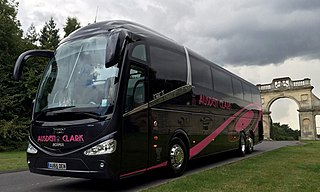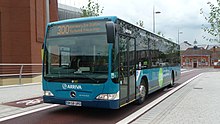
A coach is a type of bus built for longer-distance service, in contrast to transit buses that are typically used within a single metropolitan region. Often used for touring, intercity, and international bus service, coaches are also used for private charter for various purposes. Coaches are also related and fall under a specific category/type of RVs.

An articulated bus, also referred to as a slinky bus, banana bus, bendy bus, artic bus, tandem bus, double bus, vestibule bus, wiggle wagon, stretch bus, sausage bus or an accordion bus, is an articulated vehicle used in public transportation. It is usually a single-decker, and comprises two or more rigid sections linked by a pivoting joint (articulation) enclosed by protective bellows inside and outside and a cover plate on the floor. This allows a longer legal length than rigid-bodied buses, and hence a higher passenger capacity (94–120), while still allowing the bus to maneuver adequately.

A minibus, microbus, minicoach, or commuter is a passenger-carrying motor vehicle that is designed to carry more people than a multi-purpose vehicle or minivan, but fewer people than a full-size bus. In the United Kingdom, the word "minibus" is used to describe any full-sized passenger-carrying van or panel truck. Minibuses have a seating capacity of between 12 and 30 seats. Larger minibuses may be called midibuses. Minibuses are typically front engine step-in vehicles, although low floor minibuses are particularly common in Japan.

Switch Mobility is an English bus manufacturer based in Sherburn-in-Elmet, North Yorkshire. It is a subsidiary of Indian company Ashok Leyland. The company is responsible for the EV operations of the group with Ashok Leyland focusing on its core business of diesel-powered vehicles as well as work on alternative fuels like compressed natural gas (CNG), liquefied natural gas (LNG) and hydrogen.

A midibus is a classification of single-decker minibuses which are generally larger than a traditional minibus but smaller than a full-size single decker and can be anywhere between 8 metres and 11 metres long. While used in many parts of the world, the midibus is perhaps most common in the United Kingdom, where operators have found them more economical, and to have a sufficient number of seats compared to full size single-decker buses.

Arriva Scotland West was a bus company based in Inchinnan, near Paisley, Scotland. It was formed in 1997 as a rebranding of the former Clydeside 2000 company when purchased by Arriva. On 26 March 2012, the business was sold to McGill's Bus Services.

East Lancashire Coachbuilders Limited was a manufacturer of bus bodies and carriages founded in 1934 in Blackburn, Lancashire, England. The company went into administration for a short while in August 2007, before being bought by Darwen Group and performed a reverse takeover with Optare when its parent purchased the company in 2008 and its site and business was later closed in 2012.

MK Metro was a bus company operating in Milton Keynes from 1997 until 2010.

The Plaxton Centro was a low entry single-decker bus bodywork designed by Bluebird Vehicles and manufactured by Plaxton.

Stagecoach in South Wales is a bus operator providing services in South East Wales. It is a subsidiary of Stagecoach.

Arriva North West is a major bus operator running services in North West England in the Merseyside area. It is a subsidiary of Arriva UK Bus.

The Optare Esteem was a low-floor single-decker bus body manufactured by East Lancashire Coachbuilders, Darwen East Lancs and Optare between 2006 and 2009 on Scania N94UB, Scania N230UB, Volvo B7RLE, MAN 12.240, Alexander Dennis Dart SLF, Alexander Dennis Enviro200 Dart and Alexander Dennis Enviro300 chassis.

The Optare Olympus is a double-decker bus built by Optare. It could be built as a body available on Alexander Dennis Enviro400, Volvo B9TL or Scania N230UD/N270UD chassis with the 2-axle and 3-axle variants. It is the double-decker equivalent of the Optare Esteem. Some 3-axle Olympus buses were built.

The Darwen Group was a bus manufacturer located in Blackburn, Lancashire, England. The company originated from the purchase of East Lancashire Coachbuilders who went into administration in August 2007. After a series of developments, in June 2008 Darwen performed a reverse takeover in fellow bus manufacturer Optare, with the Darwen name disappearing.

The MCV Evolution is a low floor and low entry single-decker bus body built by Manufacturing Commercial Vehicles. It was unveiled in 2003 as the successor to the MCV Stirling. The MCV Evolution 2 was launched, initially on Mercedes-Benz chassis in 2011.

The East Lancs OmniDekka is a double-decker bus built for sale in the UK market, introduced by East Lancashire Coachbuilders in 2003. Originally built on Scania N94UD chassis at Euro 3, and later Scania N230UD and N270UD at Euro 4 and Euro 5, the bodywork consists of a modified East Lancs Myllennium double decker, but with the standard front end cowl and windscreen replaced with that of Scania's own integral OmniCity. Through takeovers of East Lancs, production of the OmniDekka was latterly carried out by the Darwen Group and finally Optare before ceasing in 2011.



















